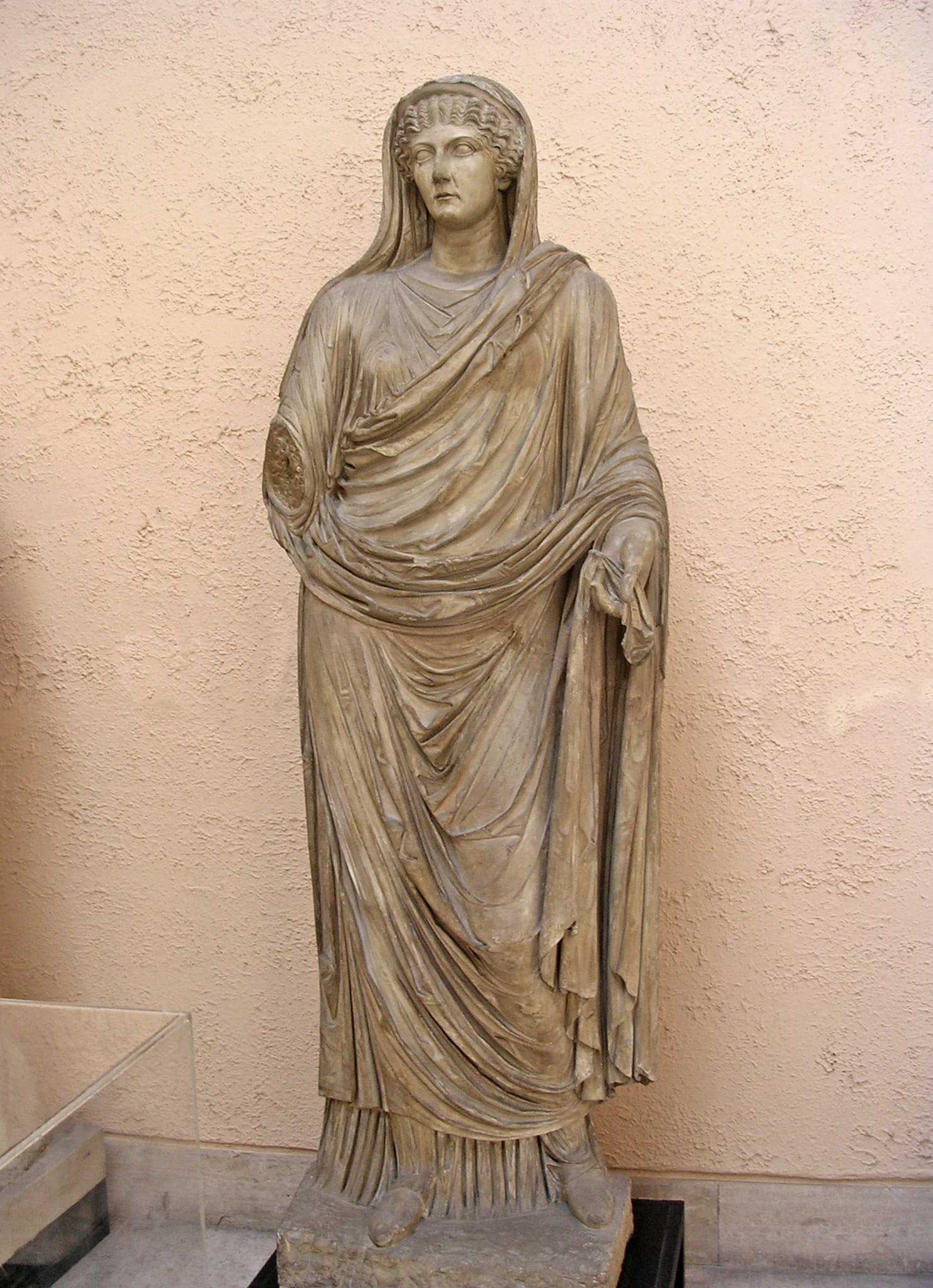
Original: Pentelic marble, reign of Caligula (37—41 CE).
Height 224.5 cm, height of the head 36.7 cm. Inv. No. MCR 291.Rome, Museum of Roman CivilizationPhoto by Olga Lyubimova
Livia (or Drusilla?).
Original: Pentelic marble, reign of Caligula (37—41 CE).
Height 224.5 cm, height of the head 36.7 cm.
Rome, Museum of Roman Civilization
(Roma, Museo della civiltà romana).
 882. Römische weibliche Gewandstatue.
882. Römische weibliche Gewandstatue.
S.366 Ueber Lebensgrösze. — It. M. — Erg. r. Hand mit den Gewandteilen und dem Ringe am ersten Glide des zweiten Fingers. Kopf mit Hals besonders gearbeitet. Der besonders gearbeitete r. Vorderarm nicht vorhanden: hie und da bestoszen, z. B. am Rande des Diadems. — Herkunft wie bei 868. — Abgeb. Antolini, a. O., IX, 3.
R. Standbein: das l. Bein ist zur Seite gesetzt. Bekleidet ist die Figur mit Zeugschuhen, einem langen, feinen, an den Oberarmen zugeknöpften Chiton und einem auf dem Kopfe aufliegenden Obergewande, das, unter dem r. Arme vorgenommen, mit einem breiten Umschlag über die l. Schulter zurückgeworfen ist. Rückseite nur angelegt. Das Gesicht (Mund geschlossen) scheint etwas überarbeitet zu sein. Das wellige, scharf ausgearbeitete Har ist über einen kleinen in die Stirn gekämmten und dort quer abgeschnittenen Teil desselben1 zur Seite gefürt und von einem Diadem bekrönt. Die Arbeit ist weniger glänzend als bei 881. Wol keine Agrippina, wie die Figur genannt wird. Livia?
1Vgl. zu 852, 2.p.125 At least two, and probably three, extant portraits of Livia come from statuary groups securely datable to the principate of Caligula157. Of these, the group from the basilica of Velleia demonstrates with greatest clarity her significance in the propaganda of the third Julio-Claudian emperor158. (Figures 45—
Poulsen F. Porträtstudien in norditalienischen Provinzmuseen. Kopenhagen, 1928. S. 52 f. № 6. Ill. 75—
Hafner G. Zum Augustus-Relief in Ravenna // MDAIR. Bd. 62. 1955. S. 168 ff. Ill. 23, 1. 24.
Furnée—
Mansuelli G. A. Il ritratto romano nell’Italia settentrionale: formazione e correnti artistiche // MDAIR. Bd. 65. 1958. S. 81 Anm. 61.
Gross W. H. Iulia Augusta. Untersuchungen zur Grundlegung einer Livia-Ikonographie. Göttingen, 1962. S. 113 f.
Bartels H. Studien zum Frauenporträt der augusteischen Zeit. Fulvia, Octavia, Livia, Julia. München, 1963. S. 57, Anm. 459.
Gross W. H. Augustus und Livia // Acta Archaeologica. Vol. 35. 1964. S. 54 Anm. 12.
Saletti C. Il ciclo statuario della basilica di Velleia. Milano, 1968. P. 33 № 4. Ill. 11—
Goethert K.-P. Zur Einheitlichkeit der Statuengruppe aus der Basilika von Velleia // MDAIR. Bd. 79. 1972. S. 235—
Jucker H. Die Prinzen des Statuenzyklus aus Veleia. Umfang und Datierung der Stiftung des L. Calpurnius Piso // JdI. Bd. 92. 1977. S. 213.
Fittschen K., Zanker P. Katalog der römischen Porträts in den Capitolinischen Museen und den anderen kommunalen Sammlungen der Stadt Rom 3. Kaiserinnen- und Prinzessinnenbildnisse. Frauenporträts. Mainz, 1983. Anm. 6, № 3.
Winkes R. Livia, Octavia, Julia. Porträts und Darstellungen. Louvain-la-Neuve, 1995. S. 153 № 76.
Wood S. E. Imperial Women: A Study in Public Images, 40 BC — AD 68. Leiden; Boston; Köln, 2000. P. 125—
Boschung D. Gens Augusta: Untersuchungen zu Aufstellung, Wirkung und Bedeutung der Statuengruppen des julisch-claudischen Kaiserhauses. Mainz, 2002. S. 25, № 2. 6б Ill. 16, 1. 18, 1. 3.
© 2018. Text: iDAI.Images / Arachne.
Description: Dütschke H. Antike Bildwerke in Oberitalien V. Antike Bildwerke in Vicenza, Venedig, Catajo, Modena, Parma und Mailand. Leipizig, 1882. № 882.
© 2000. Description: Wood S. E. Imperial Women: A Study in Public Images, 40 BC — AD 68. Leiden; Boston; Köln, 2000. P. 125—126.
